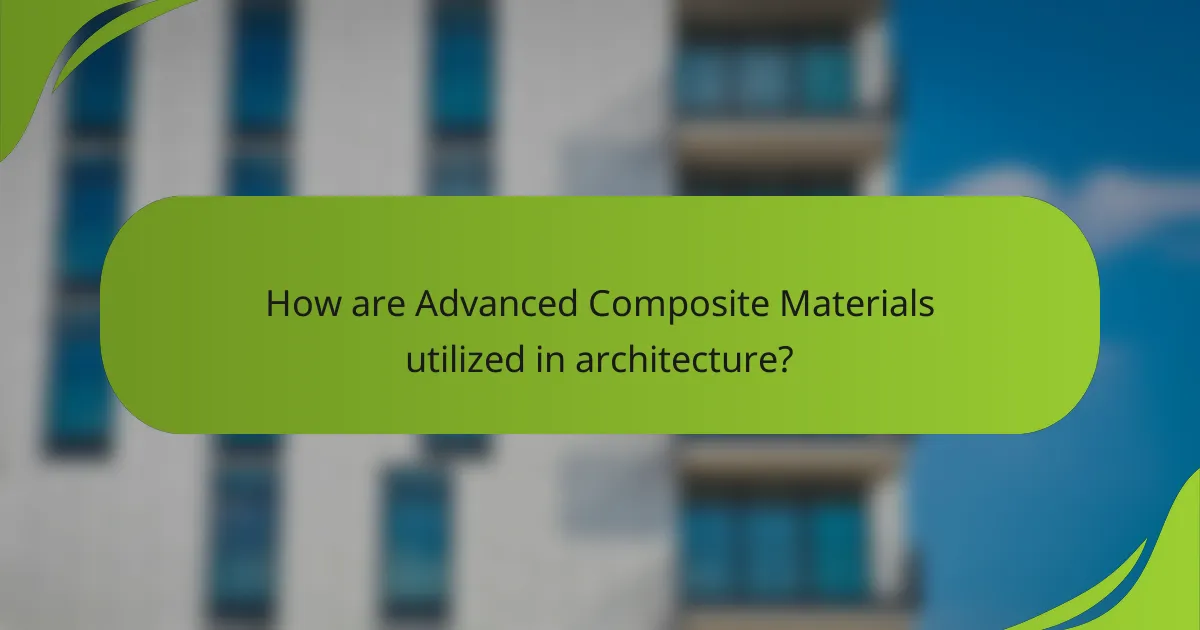Advanced composite materials are engineered substances created from two or more distinct materials, such as carbon or glass fibers combined with a polymer matrix. These composites offer a high strength-to-weight ratio, making them ideal for applications in aerospace, automotive, and construction industries. Their lightweight nature and superior mechanical properties allow for innovative architectural designs, reducing overall structural load and enhancing energy efficiency. Future trends indicate a shift towards bio-based composites and smart materials, as well as advancements in 3D printing technology, which aim to improve sustainability and accessibility in building solutions.

What are Advanced Composite Materials?
Advanced composite materials are engineered materials made from two or more constituent materials with significantly different physical or chemical properties. These materials combine the high strength-to-weight ratio of fibers, such as carbon or glass, with a polymer matrix that binds them together. The result is a material that is lightweight yet possesses superior mechanical properties. Advanced composites are used in various applications, including aerospace, automotive, and construction. Their ability to withstand extreme conditions and reduce overall weight makes them ideal for innovative architectural designs. Research shows that using advanced composites can lead to structures that are both stronger and more efficient, highlighting their importance in modern engineering.
How do Advanced Composite Materials differ from traditional materials?
Advanced composite materials differ from traditional materials primarily in their composition and performance characteristics. Traditional materials, such as metals and plastics, are typically homogeneous and exhibit uniform properties. In contrast, advanced composite materials consist of two or more distinct components, usually a matrix and a reinforcement. This combination allows for enhanced strength-to-weight ratios and improved durability. For example, carbon fiber reinforced polymers can be significantly lighter yet stronger than steel. Additionally, advanced composites often exhibit superior resistance to corrosion and fatigue compared to traditional materials. These properties make them particularly suitable for applications in aerospace and architecture, where weight reduction and structural integrity are critical.
What are the key components of Advanced Composite Materials?
The key components of Advanced Composite Materials include a matrix and reinforcement. The matrix is typically a polymer, metal, or ceramic that binds the reinforcement together. Reinforcement often consists of fibers, such as carbon, glass, or aramid. These fibers provide strength and stiffness to the composite. The combination of matrix and reinforcement results in materials that have superior mechanical properties. Advanced composites are known for their lightweight nature and high strength-to-weight ratios. This makes them ideal for applications in aerospace, automotive, and construction industries. Their unique properties enable innovative architectural designs and improved structural performance.
What properties make Advanced Composite Materials unique?
Advanced Composite Materials are unique due to their exceptional strength-to-weight ratio. This property allows them to outperform traditional materials like steel and aluminum. They exhibit high resistance to corrosion and fatigue, enhancing their durability. Advanced composites can also be tailored for specific applications, providing versatility. Their ability to absorb vibrations makes them suitable for applications in aerospace and automotive industries. Additionally, these materials can be engineered for thermal stability, making them effective in extreme environments. Overall, their combination of lightweight, strength, and adaptability sets them apart in modern engineering.
What are the primary benefits of using Advanced Composite Materials?
The primary benefits of using Advanced Composite Materials include high strength-to-weight ratio, corrosion resistance, and design flexibility. These materials are significantly lighter than traditional materials like steel and aluminum. This weight reduction leads to improved fuel efficiency in transportation applications. Advanced composites also resist environmental degradation, enhancing their longevity and reducing maintenance costs. Their versatility allows for complex shapes and structures, enabling innovative designs in architecture. Additionally, they can be tailored for specific performance requirements, improving overall efficiency in various applications.
How do these materials contribute to strength in construction?
Advanced composite materials enhance strength in construction through their high tensile and compressive strength. These materials, such as carbon fiber and glass fiber composites, exhibit superior resistance to deformation under load. Their lightweight nature allows for easier handling and installation without compromising structural integrity. Additionally, composites resist corrosion and environmental degradation, which prolongs the lifespan of structures. Studies show that using advanced composites can reduce overall material weight by up to 50%, while maintaining or even increasing strength. This combination of strength and reduced weight leads to more efficient designs and improved performance in various architectural applications.
What role do Advanced Composite Materials play in weight reduction?
Advanced Composite Materials significantly contribute to weight reduction in various applications. These materials, such as carbon fiber and fiberglass, possess high strength-to-weight ratios. This means they can provide the same structural integrity as traditional materials while being much lighter. For instance, carbon fiber composites can be up to five times lighter than steel. In aerospace, using these composites can lead to a weight reduction of 20-30%. This reduction enhances fuel efficiency and performance in aircraft. Additionally, in automotive applications, advanced composites can reduce vehicle weight, improving fuel economy and reducing emissions. Therefore, the role of Advanced Composite Materials in weight reduction is critical across multiple industries.

How are Advanced Composite Materials utilized in architecture?
Advanced composite materials are utilized in architecture for their strength-to-weight ratio and design flexibility. These materials include carbon fiber, glass fiber, and aramid fiber composites. They are used in structural components, facades, and roofing systems. Their lightweight nature reduces the overall load on structures. This leads to lower material costs and improved energy efficiency. Additionally, advanced composites offer resistance to corrosion and environmental degradation. Studies show that these materials can enhance the lifespan of buildings. Their application in architectural design allows for innovative shapes and forms that traditional materials cannot achieve.
What types of structures benefit most from Advanced Composite Materials?
Advanced composite materials benefit most structures that require high strength-to-weight ratios. These include aerospace structures like aircraft wings, which need lightweight materials for efficiency. Automotive components also benefit, as reduced weight improves fuel efficiency. Civil engineering structures, such as bridges and buildings, utilize composites for enhanced durability and resistance to environmental factors. Wind turbine blades use advanced composites to maximize strength while minimizing weight. Additionally, marine structures, like boats and ships, leverage these materials for improved performance and longevity. These applications highlight the versatility and effectiveness of advanced composite materials in various structural contexts.
How do Advanced Composite Materials enhance architectural design?
Advanced Composite Materials enhance architectural design by providing superior strength and lightweight properties. These materials allow for innovative structural forms that were previously unattainable. For example, carbon fiber composites are five times stronger than steel yet significantly lighter. This enables architects to create more expansive spaces without the need for excessive support structures. Additionally, composites can be molded into complex shapes, allowing for unique aesthetic designs. Their resistance to environmental factors also contributes to the longevity of structures. According to a study published in the Journal of Materials in Civil Engineering, using advanced composites can reduce overall building weight by up to 30%. This weight reduction translates to lower material costs and improved energy efficiency in buildings.
What are some examples of innovative projects using these materials?
Innovative projects using advanced composite materials include the Eden Project in the UK. This project utilizes composite materials for its geodesic domes, enhancing structural strength while reducing weight. Another example is the Airbus A350, which incorporates carbon fiber reinforced polymer for improved fuel efficiency. The Elbphilharmonie concert hall in Hamburg uses composite materials for its unique wave-like roof design. Additionally, the Hyperloop transportation concept employs lightweight composites to achieve high speeds. These examples demonstrate the versatility and advantages of advanced composite materials in modern architecture and design.
What challenges are associated with the use of Advanced Composite Materials in architecture?
Advanced Composite Materials face several challenges in architecture. One challenge is their high initial cost, which can limit widespread adoption. Additionally, the complexity of manufacturing processes can lead to difficulties in achieving consistent quality. Another issue is the lack of established building codes specifically for these materials. This can create uncertainty for architects and builders. Furthermore, the long-term durability and performance of these materials in various environmental conditions remain under research. Maintenance requirements may also differ from traditional materials, complicating lifecycle management. Lastly, the recyclability of Advanced Composite Materials poses environmental concerns, as many are not easily recyclable.
How do cost considerations impact the adoption of Advanced Composite Materials?
Cost considerations significantly impact the adoption of Advanced Composite Materials. High initial costs can deter manufacturers from integrating these materials into their products. For example, the production of advanced composites often involves expensive raw materials and complex manufacturing processes. These factors lead to higher upfront investments compared to traditional materials.
Additionally, the long-term benefits of advanced composites may not be immediately apparent. While they offer advantages like weight reduction and increased strength, the return on investment can take time to materialize. Studies show that lifecycle cost analysis is crucial for decision-making in industries like aerospace and automotive.
In these sectors, the durability and performance of advanced composites can offset initial costs over time. Therefore, understanding both short-term expenses and long-term savings is essential for successful adoption.
What are the environmental implications of using these materials?
The environmental implications of using advanced composite materials include resource consumption and waste generation. These materials often require significant energy for production, leading to carbon emissions. For instance, the manufacture of carbon fiber composites can produce up to 25 kg of CO2 per kilogram of material. Additionally, the disposal of composites can be challenging. Many composites are not biodegradable and contribute to landfill waste. Recycling options are limited, but advancements are being made in reclaiming fibers. The overall lifecycle assessment indicates that while these materials reduce weight and improve efficiency, their environmental footprint must be managed carefully.

What are the future trends for Advanced Composite Materials in architecture?
Future trends for advanced composite materials in architecture include increased use of bio-based composites. These materials are made from renewable resources, reducing environmental impact. Another trend is the integration of smart materials that respond to environmental changes. These materials can adapt to temperature and humidity variations, enhancing building performance. Additionally, 3D printing with composites is gaining traction. This technology allows for complex designs and reduces waste during construction. The focus on sustainability is also driving the development of lightweight composites. These materials improve energy efficiency by reducing structural load. Furthermore, advancements in manufacturing techniques are making composites more affordable and accessible. These innovations support the growing demand for high-performance, durable, and sustainable building solutions.
How is technology influencing the development of Advanced Composite Materials?
Technology significantly influences the development of Advanced Composite Materials by enhancing their properties and manufacturing processes. Innovations in materials science enable the creation of composites with superior strength-to-weight ratios. Advanced computer modeling allows for precise simulations of material behavior under various conditions. Automation in manufacturing improves consistency and reduces production costs. Nanotechnology contributes to the development of lighter and stronger materials. Additionally, advancements in 3D printing facilitate the rapid prototyping of complex composite structures. These technological improvements lead to broader applications in industries such as aerospace, automotive, and construction.
What innovations are on the horizon for these materials?
Innovations on the horizon for advanced composite materials include the development of bio-based composites. These materials aim to reduce environmental impact while maintaining strength and durability. Researchers are also focusing on self-healing composites that can repair damage autonomously. This technology promises to extend the lifespan of structures significantly. Additionally, advancements in 3D printing techniques are enabling the creation of complex geometries that were previously impossible. These innovations enhance the design flexibility of architectural applications. Furthermore, the integration of smart materials is being explored, allowing structures to respond to environmental changes. These developments are backed by ongoing research in materials science and engineering, indicating a robust future for advanced composites in architecture.
How might sustainability shape the future of Advanced Composite Materials?
Sustainability will significantly influence the future of Advanced Composite Materials. Manufacturers are increasingly focusing on eco-friendly production methods. This includes using renewable resources and reducing carbon footprints. The demand for recyclable materials is rising. Advanced composites can be designed for easier recycling and reusability. Innovations in bio-based composites are emerging. These materials often have lower environmental impacts compared to traditional options. Additionally, regulatory pressures are driving sustainability in material selection. Companies that prioritize sustainable practices may gain a competitive edge. The shift towards sustainability aligns with global efforts to combat climate change.
What practical tips should architects consider when using Advanced Composite Materials?
Architects should prioritize material selection based on performance characteristics. Advanced composite materials offer high strength-to-weight ratios. They can significantly reduce structural loads. Architects must understand the specific properties of each composite type. Conduct thorough testing to ensure durability and longevity. Consider environmental impacts and sustainability in material choices. Collaborate with engineers for optimal design integration. Utilize advanced modeling software to simulate performance under various conditions. These practices enhance project outcomes and ensure structural integrity.
How can architects ensure the successful integration of these materials in their designs?
Architects can ensure the successful integration of advanced composite materials by conducting thorough material research. This involves understanding the properties and performance characteristics of each material. Architects should also engage in early collaboration with engineers and material scientists. This collaboration helps in addressing design challenges and optimizing material use.
Additionally, architects should utilize simulation tools for performance analysis. These tools can predict how materials will behave under various conditions. Testing prototypes before final implementation further confirms material suitability. Continuous education on emerging trends and technologies is vital for architects. Staying updated enhances their ability to make informed decisions regarding material integration.
What best practices should be followed for maintenance and durability of Advanced Composite Materials?
Regular inspection is essential for maintaining advanced composite materials. Inspect for surface damage, delamination, and environmental wear. Clean the materials using mild detergents and soft cloths to avoid scratching. Store these materials in a controlled environment to prevent exposure to extreme temperatures and humidity. Use appropriate protective coatings to enhance durability against UV radiation and chemicals. Follow manufacturer guidelines for repair techniques when damage occurs. Employ non-destructive testing methods to assess structural integrity periodically. Research indicates that proper maintenance can extend the lifespan of composite materials significantly, ensuring their performance in architectural applications.
Advanced composite materials are engineered materials that combine two or more constituents with different properties, resulting in lightweight yet strong materials ideal for various applications, including aerospace, automotive, and architecture. This article explores the unique properties, benefits, and challenges of advanced composites, highlighting their superior strength-to-weight ratios, corrosion resistance, and design flexibility. It also examines their role in innovative architectural designs, future trends towards sustainability, and technological advancements shaping their development. Additionally, practical tips for architects on material integration and maintenance are provided, ensuring optimal performance and durability in construction projects.